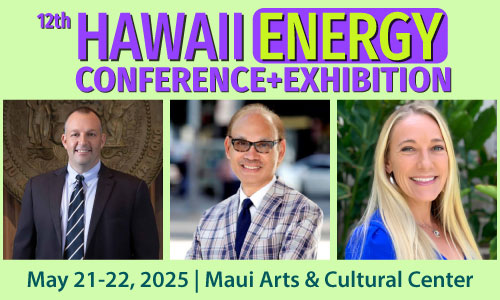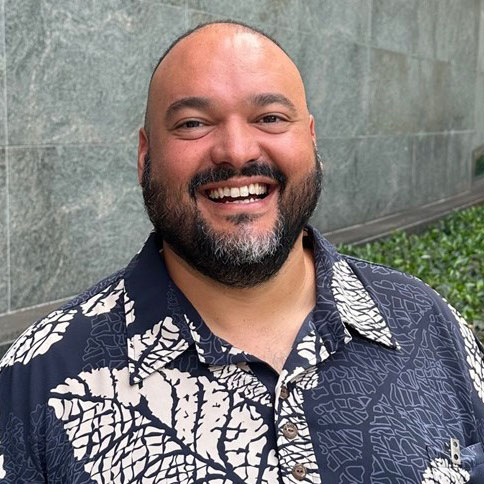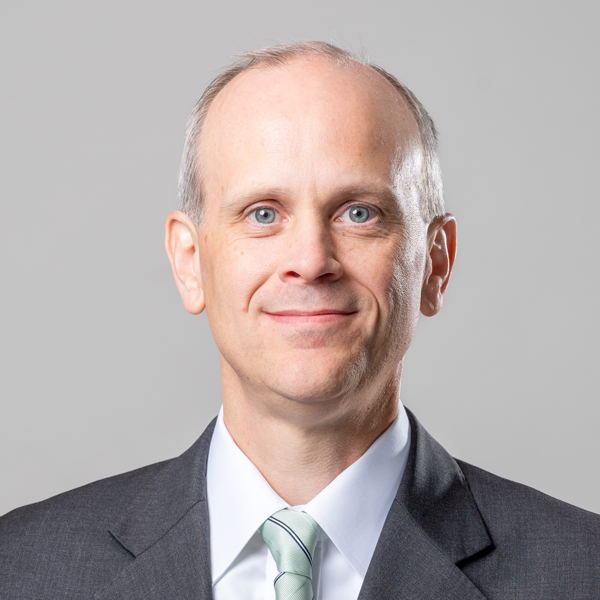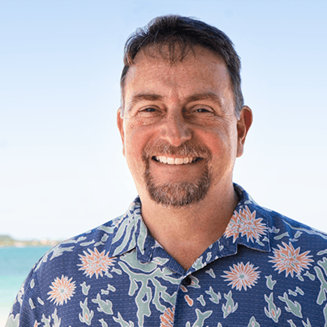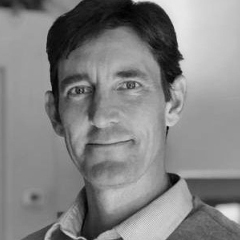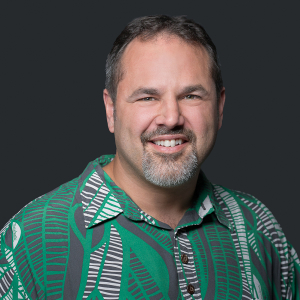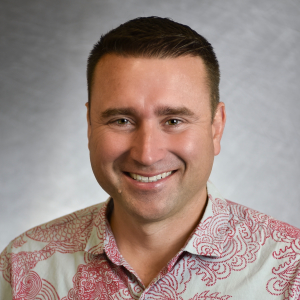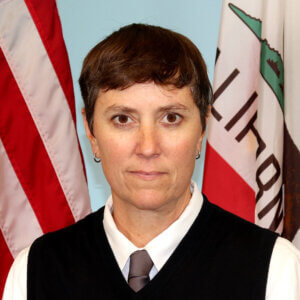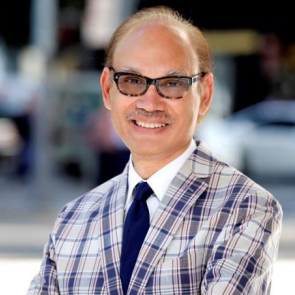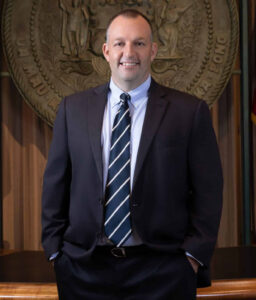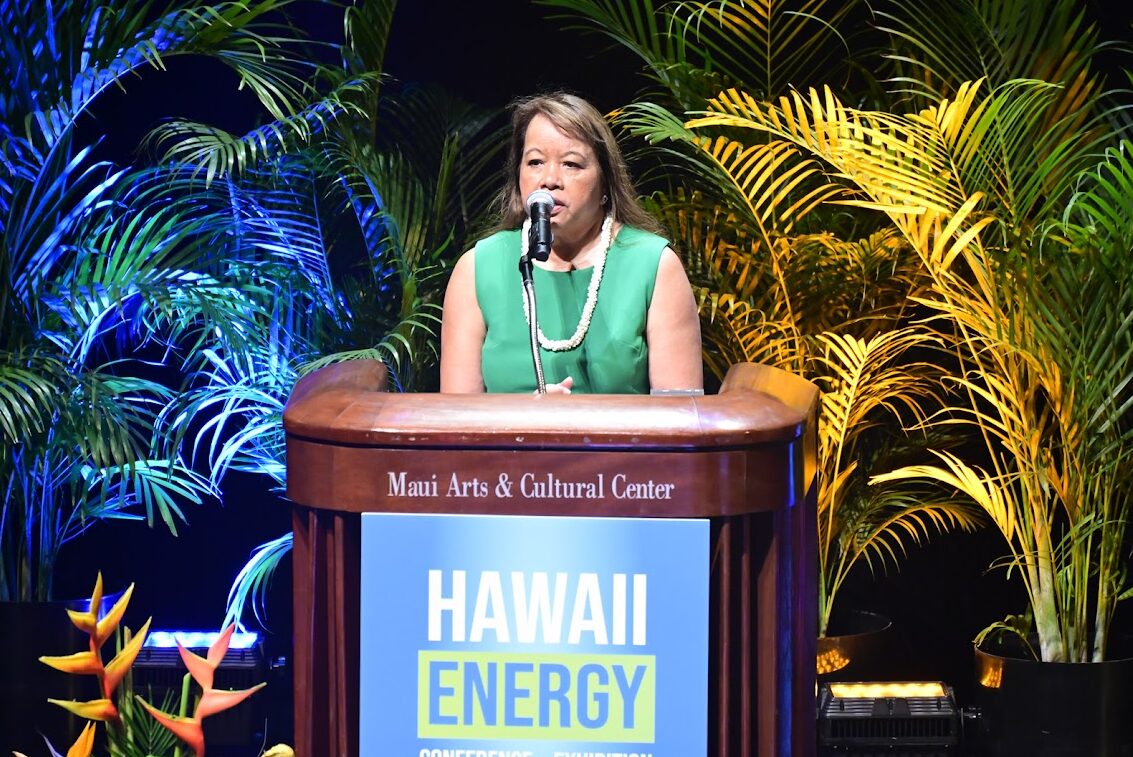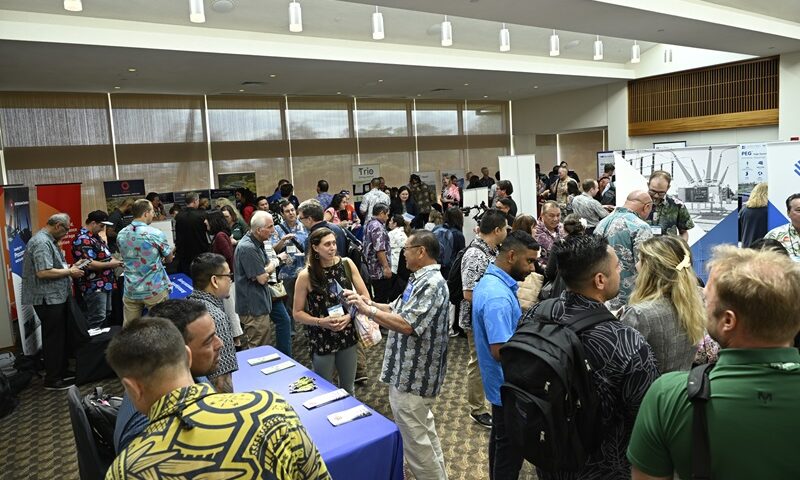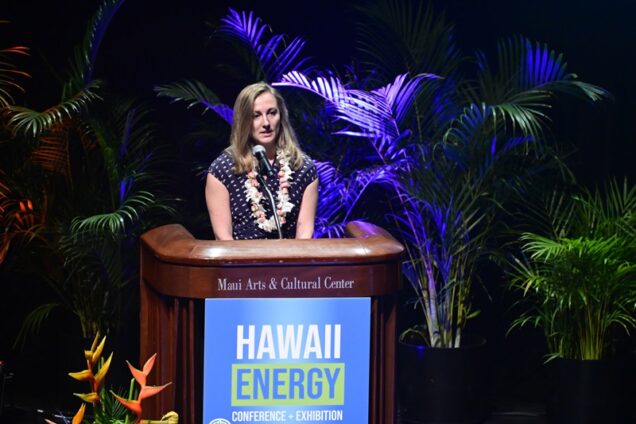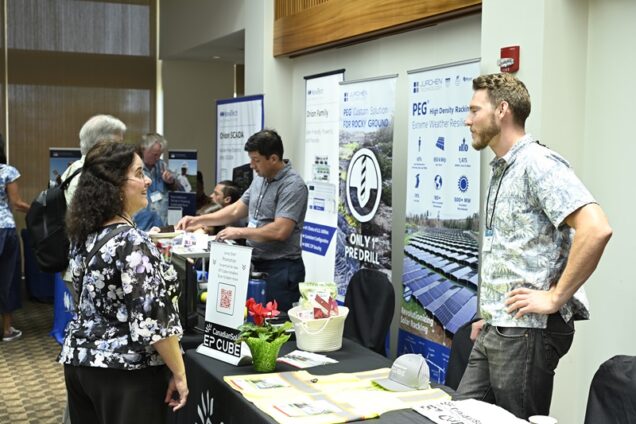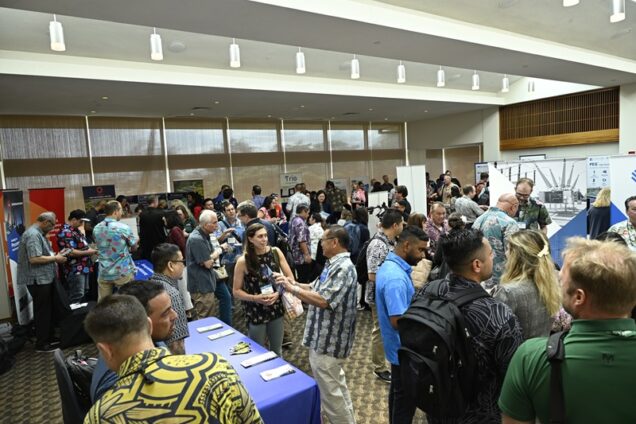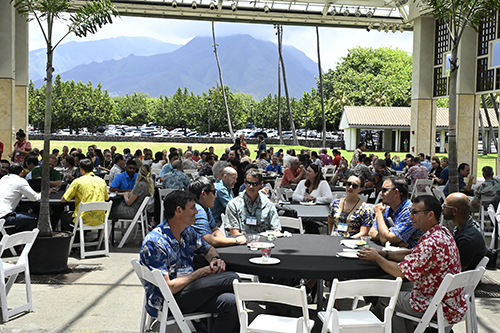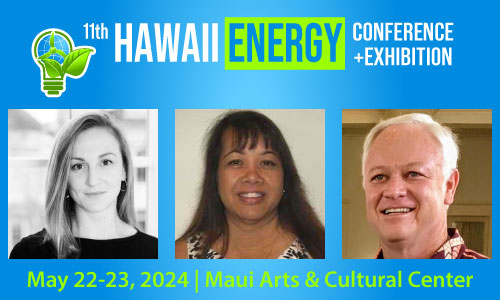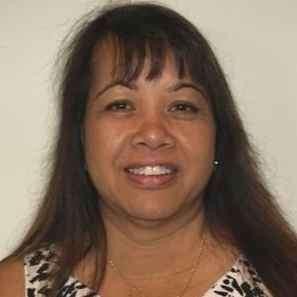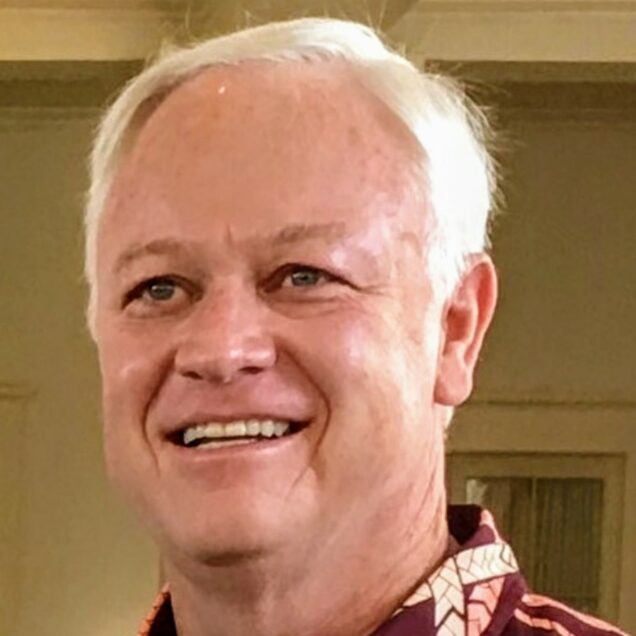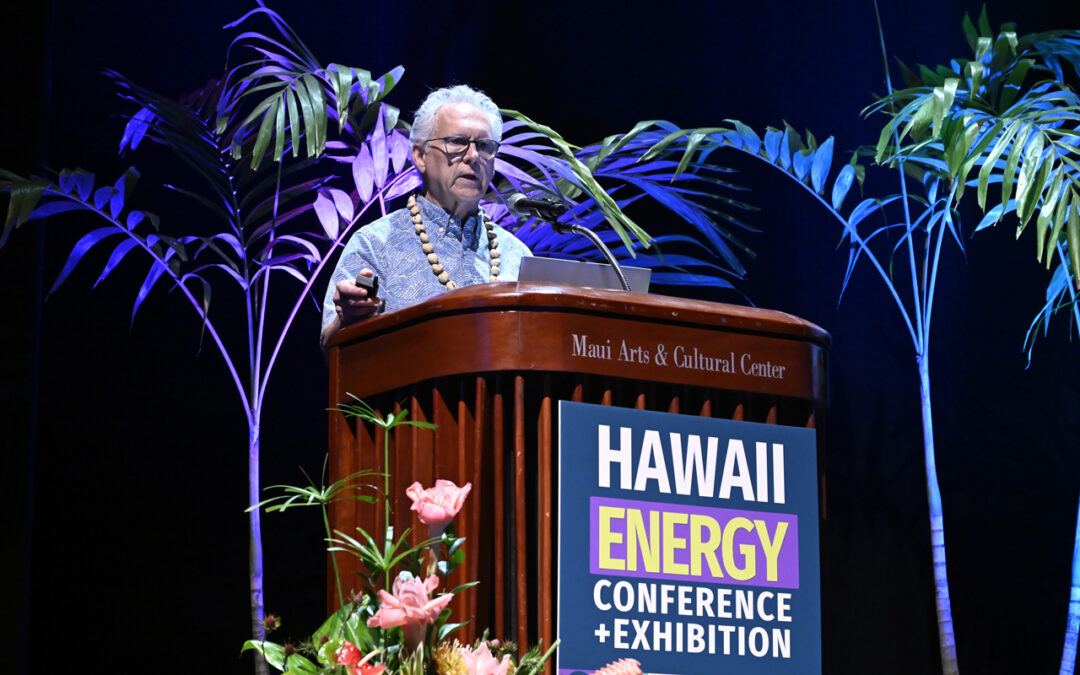
Energy Leaders Convene in Maui to Tackle Tough Challenges and Offer Real Solutions
The 12th Annual Hawaii Energy Conference (HEC), held May 21–22 in Maui, brought together 365 energy leaders, policymakers, innovators, and community advocates to explore actionable strategies for Hawaii’s transition to a clean energy future under the theme “Offering Solutions.”
Hosted by the Maui Economic Development Board, the two-day conference featured dynamic keynote addresses, engaging panels, and in-depth discussions on the state’s most pressing energy challenges ranging from affordability and grid reliability to community priorities and advanced technologies.
Mayor Richard Bissen gave opening remarks with a focus on Maui County’s commitment to sustainability through energy efficiency, water conservation, and culturally rooted decision-making. He highlighted completed upgrades at 139 county facilities and solar battery installations at 34 more, which are reducing costs, conserving over 81 million gallons of water annually, and creating local jobs.
Mark Glick, Chief Energy Officer of the Hawaii State Energy Office, delivered an extended introduction to the first panel of the day, replacing Governor Josh Green, M.D., who was unable to attend due to commitments in Washington, D.C. Glick outlined the state’s bold goal—accelerating to 100% renewable energy for Maui County, Hawaii, and Kauai by 2035. He emphasized the importance of reducing oil price volatility, improving grid reliability, and investing in local biofuels like sunflower-based biodiesel. Glick also raised critical questions about the alignment between Hawaii’s decarbonization laws and its renewable portfolio standards, urging a thoughtful balance between emissions reduction and energy self-sufficiency.
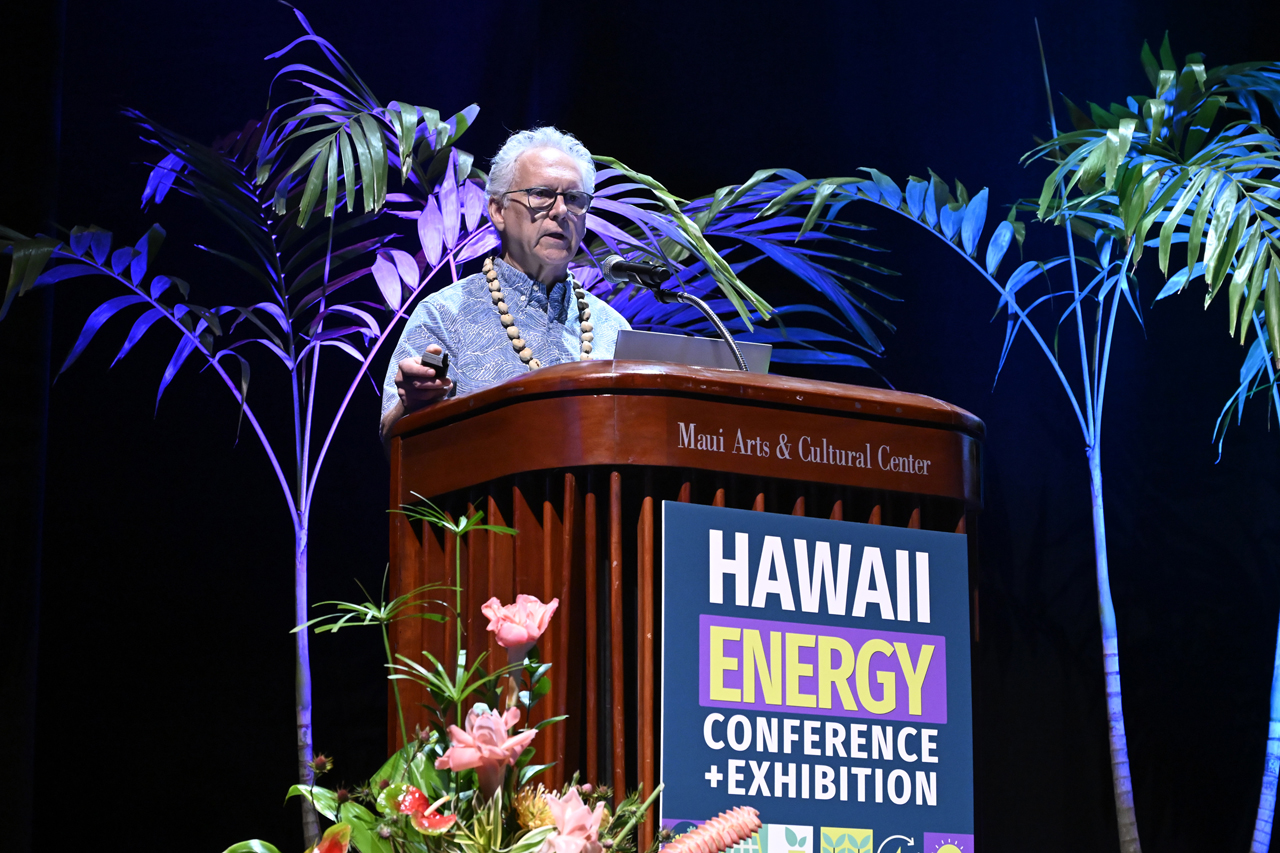
Mark Glick addressed the 2025 Hawaii Energy Conference
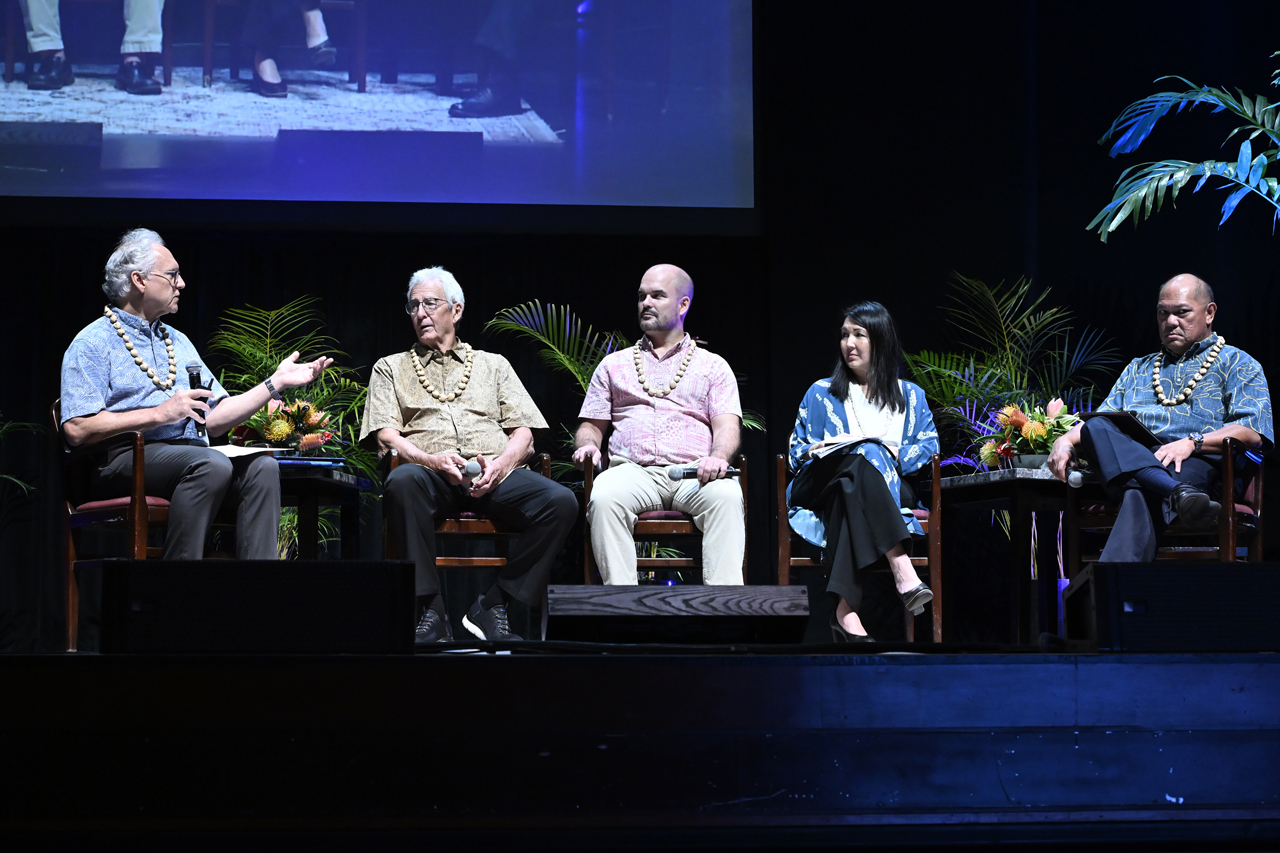
Panel L to R: Mark Gllick, Rick Rocheleau, Michael Angelo, Shelee Kimura, Leo Ascunsion
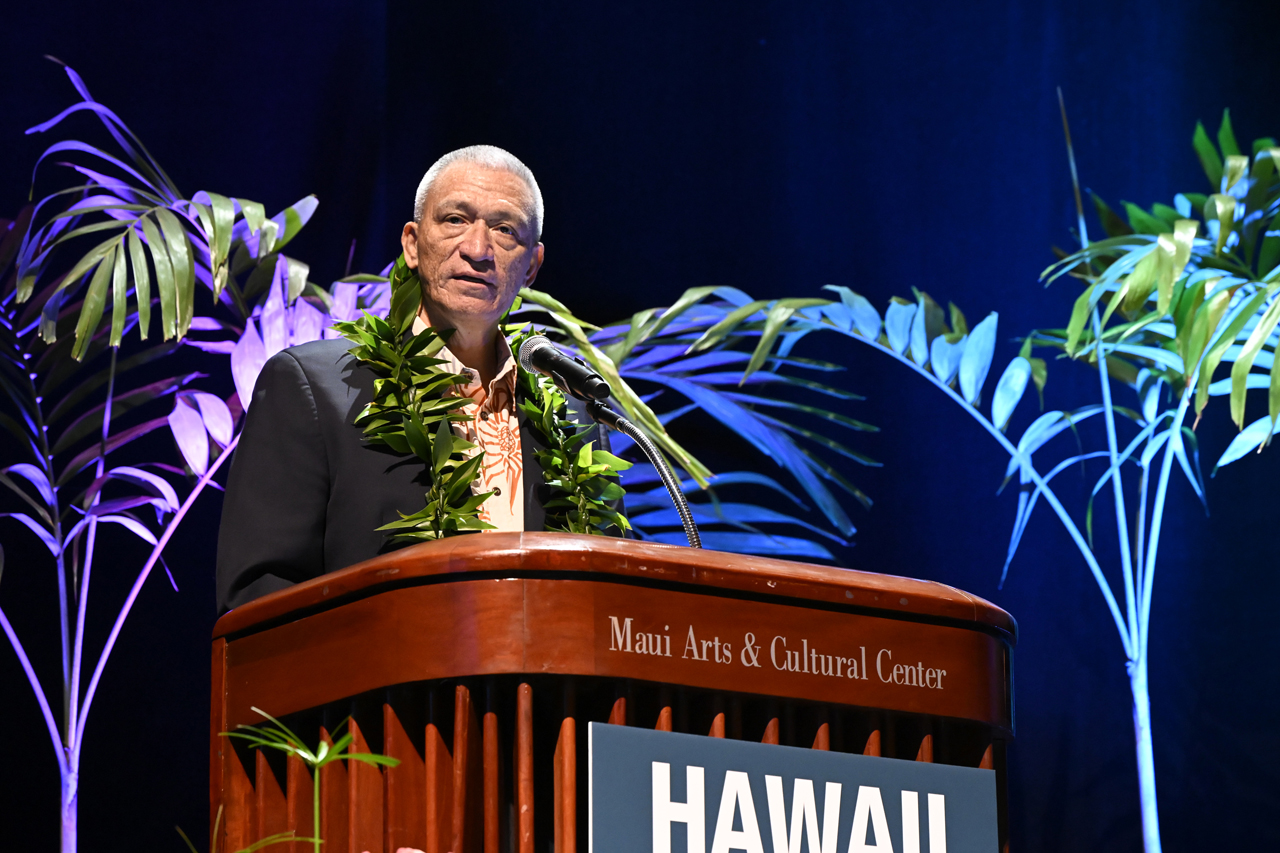
Mayor Richard Bissen gave opening remarks at HEC 2025
Glick was then joined on the stage by energy and regulatory leaders Shelee Kimura, President & CEO, Hawaiian Electric; Leo Asuncion, Chair, Public Utilities Commission; and Michael Angelo Executive Director, Division of Consumer Advocacy; and Rick Rocheleau, Director, Hawai‘i Natural Energy Institute; to discuss ‘Repowering & Resilience.’ The conversation focused on the dual imperatives of meeting Hawaii’s Renewable Portfolio Standard (RPS) and Act 238 carbon neutrality goals, while ensuring affordability, reliability, and community engagement.
“It takes every one of us in this room, everybody on this stage, all of our partners here to make all of these things happen — to achieve these very aggressive goals Hawaii has,” said Kimura.
This year’s conference saw the introduction of a Deep Dive Session to provide an opportunity to explore a complex topic in greater detail with an intimate group. Led by economist Dr. Ahmad Faruqui, Jeremy Kwock, Manager of Pricing for Hawaiian Electric, and Jennifer Potter, Faculty Energy Specialist, Hawaii Natural Energy Institute, the session examined the design of Time-of-Use (TOU) rates for Hawaii. Drawing from case studies in California, Michigan, Australia, and beyond, the group discussed how TOU structures could be adapted to Hawaii’s unique context—where solar is abundant, electric rates are high, and energy equity is paramount.

Dr. Ahmad Faruqui leads the Deep Dive Session at the 2025 Hawaii Energy Conference
In addition to the general sessions, the conference provided networking opportunities for attendees with breakfast, lunch and receptions. The exhibit venue showcased organizations with the latest renewable-energy technologies and services.
What keeps me coming back, I think is this is really the premier energy focused conference for Hawaii, said Jack Shriver, Power Engineers. “I mean people are really here to engage and to solve problems.”
“Hawaii and Puerto Rico are so similar,” said Antonio Torres-Miranda, Associate Commissioner, Energy Bureau of the Puerto Rico Public Service Regulatory Board. “I’m taking a lot of solutions that they’ve given to Hawaii to Puerto Rico and implement them in Puerto Rico. It’s been good for us. For me, it’s been a learning experience.” Torres-Miranda spoke on a panel on Puerto Rico’s emerging VPP initiatives.
“I feel like I’ve been here since the beginning and I haven’t missed one since,” said Brian Keoloha of VEIC. “This is just the place to be for discussions around energy policy — How do we push and move the needle in Hawaii around energy issues? Having discussions in the panel form with some of the best practices and things that we can learn from other jurisdictions. The conversations that we need to have amongst our peers and other folks that are working in this space — it’s just a great convening.”
The conference closed with a final networking opportunity; a Pau Hana reception sponsored by Women in Renewable Energy (WiRE). WiRE’s mission, to advance the role and recognition of women and other underrepresented groups working in the energy sector.
The 2025 Hawaii Energy Conference was sponsored by Ulupono Initiative, Hawaii Natural Energy Institute, Moss & Associates, Hawaii Energy/Leidos, Hawaiian Electric, IBEW Local Union 1186, Island Energy Services, Johnson Controls, Par Hawaii, TerraForm Power, Aeroseal, AES Hawaii, Ameresco, Bitzer, Generac, Hawaii Gas, JM Distributed, Kuaui Island Utility Cooperative, NovaTech Automation, Pacific Panel Cleaners, POWER Engineers, RevoluSun, and Trio Energy Alliance.
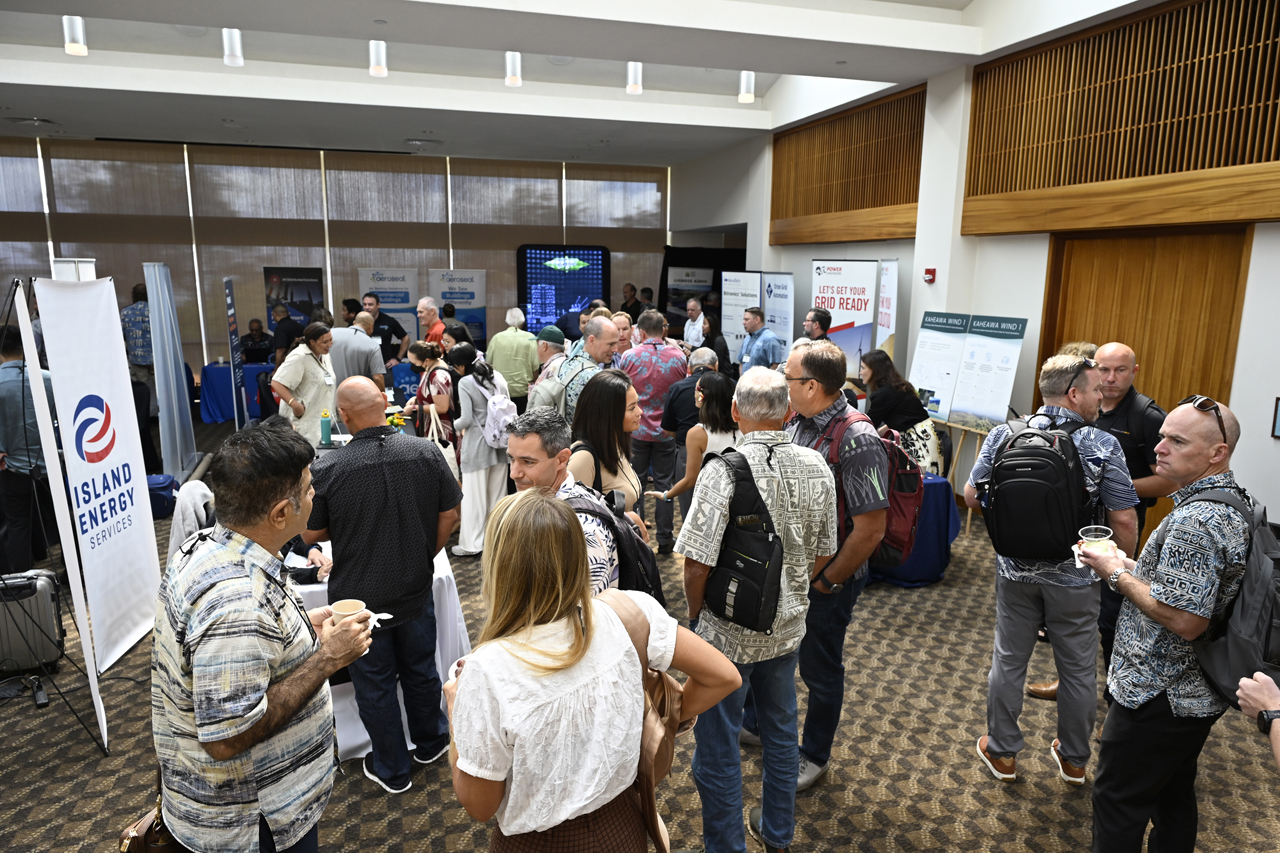
Attendees network in the Exhibit venue at the 2025 Hawaii Energy Conference
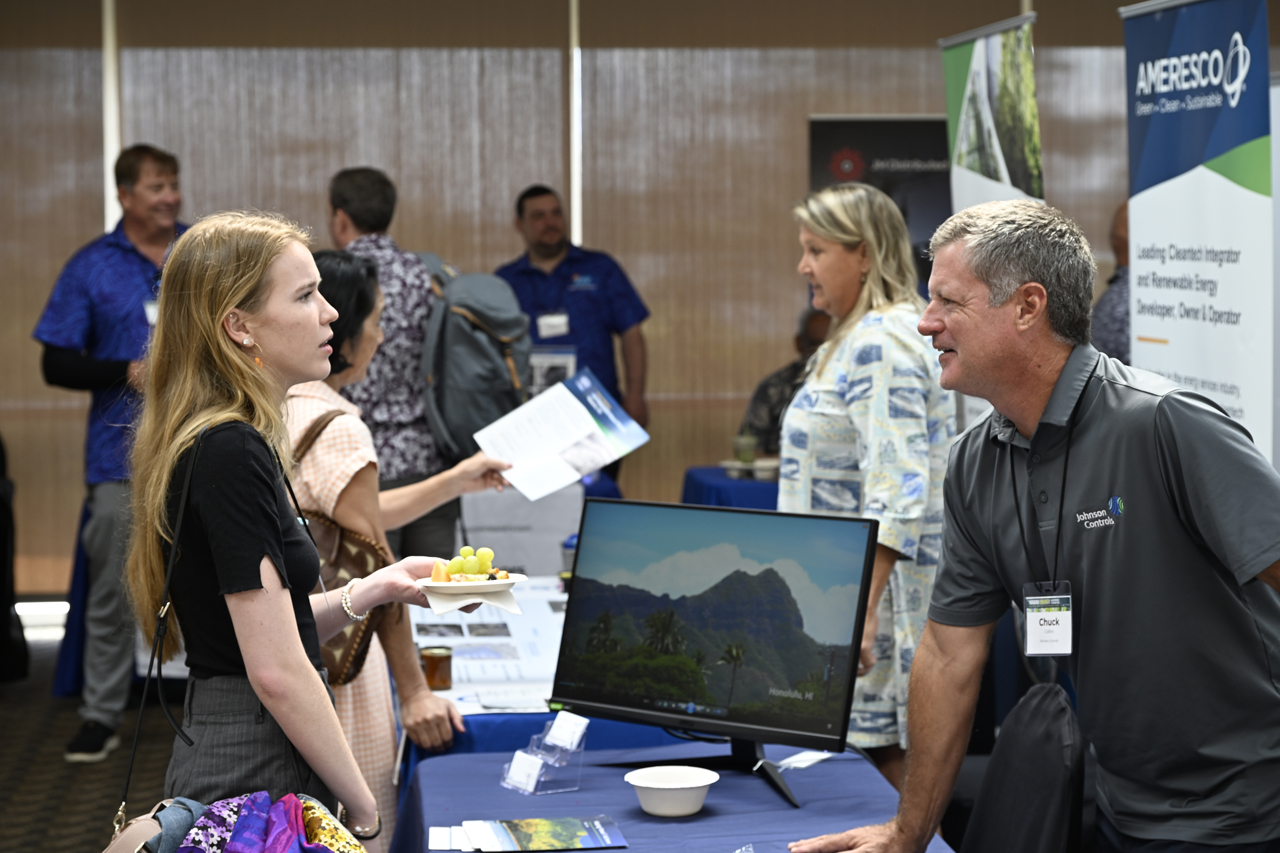
Exhibitors showcased products and services in Morgado Hall at the MACC
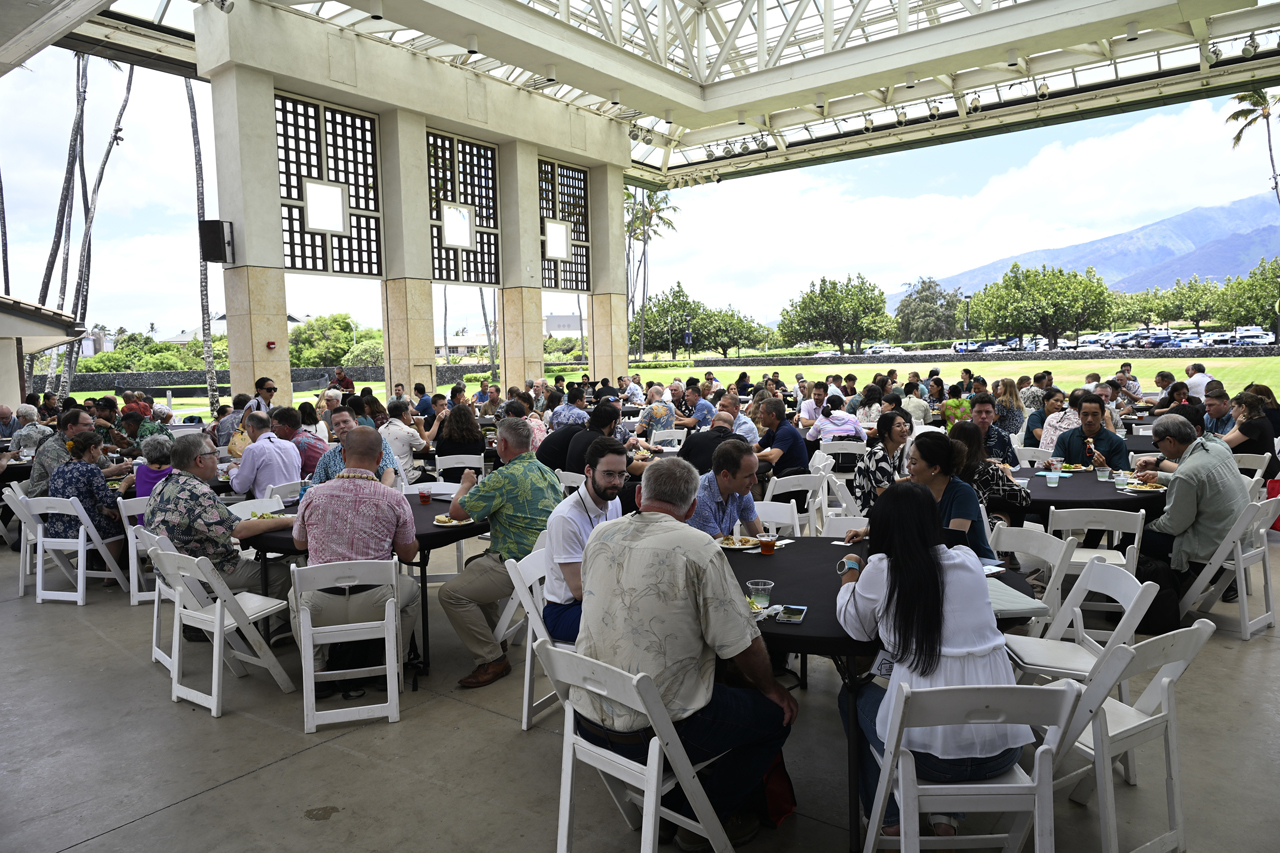
Attendees enjoy lunch in the Founders Courtyard at the Hawaii Energy Conference
Continue ready for highlights from the two days of presentations of the 12th Hawaii Energy Conference
HIGHLIGHTS FROM DAY 1
Repowering & Resilience
The first panel, as mentioned earlier, was moderated by Mark Glick with panelists Michael Angelo, Leo Asuncion, Shelee Kimura, and Rick Rocheleau. The panelists unanimously agreed that achieving both RPS and carbon neutrality goals is essential and must be pursued in tandem. Asuncion emphasized the importance of long-term planning, noting, “We’re not just going to celebrate in 2045 if we meet 100% RPS—it’s how do we maintain that going forward?”
Kimura highlighted the need to modernize aging infrastructure and firm generation to support increasing renewable integration. Rocheleau provided a technical perspective, stressing the urgency of decision-making and community acceptance. He noted that over 50% of selected solar projects had been canceled, stating, “We need to revisit how we go about getting these projects in the ground… and reduce our greenhouse gas footprint while we’re doing it.” He advocated for geothermal, wind, and especially solar with storage on Oahu, calling for more creative use of rooftops and behind-the-meter systems.
There was a strong consensus that delays in decision-making and project implementation are hindering progress. Rocheleau added, “We’re really at a point where we have to make some firm decisions…we’re kind of stagnating.”
Michael Angelo, representing consumer advocacy, focused on affordability and equity. He pointed out that over half of Hawaiian Electric’s operating costs are tied to fossil fuels and emphasized the need for cost-effective renewable solutions. “We need to aggressively pursue generation that is cost-effective and delivers the carbon benefits we need,” he said. The panel concluded with a call for accelerated action, strategic investment, and deeper community engagement to ensure a resilient, clean, and equitable energy future for Hawaii.
Geothermal Update
Mike Kaleikini, Senior Director for Hawaii Affairs at ORMAT Technologies, presented an update on the state of geothermal energy in Hawaii, focusing on the Puna Geothermal Venture (PGV) on Hawaii Island. Operating since 1993, PGV currently produces 38 megawatts and is undergoing a repowering project to increase capacity to 46 megawatts by 2026 using more efficient, modern equipment. Kaleikini emphasized Hawaii’s vast geothermal potential due to its volcanic activity but noted that development has been slow due to funding challenges, permitting, and limited exploration. He advocated for more state investment in geophysical studies to identify viable geothermal sites, pointing out that the state owns the mineral rights and would benefit from royalties.
“In order for us to transition to 100% renewable, a key element is that we need technology that can do the ramping up and the ramping down automatically…” said Kaleikini adding that it was an essential feature for grid stability. In terms of longevity, he stated that geothermal plants can operate for 50+ years with proper maintenance and upgrades, making them a reliable and long-term renewable energy solution.
OHA’s Views on Energy
Carmen Hulu Lindsey, Maui Trustee for the Office of Hawaiian Affairs, offered a on energy from a Native Hawaiian standpoint, emphasizing the need to align energy development with cultural stewardship and community well-being.
“I’m here to emphasize that our journey toward energy sustainability is not simply technical or political, it is spiritual, it is cultural, and it is urgent,” said Hulu Lindsey. She did warn the audience that all transformation must be Pono. “We cannot claim to be sustainable if our systems are unjust. A solar farm that displaces sacred land is not Pono. A wind project that ignores community voices is not sustainable. A grid that leaves rural, native Hawaiian and low-income communities behind is not just. As we move forward, we must center indigenous perspectives and practices in our decision-making.”
Power and Fire: How Utilities Are Confronting the Growing Wildfire Threat
Moderator Jonathan Koehn of the City of Boulder opened this panel by acknowledging the emotional and practical weight of recent disasters, highlighting the “trifecta” of intensifying heat, drought, and wind that has made power infrastructure more vulnerable. He was joined by Caroline Thomas Jacobs of California’s Office of Energy Infrastructure Safety, Mathew McNeff of Hawaiian Electric, and Brad Rockwell from Kauai Island Utility Cooperative to discuss how hardening the grid, using AI monitoring, and working across jurisdictions can help mitigate risk.
Thomas Jacobs emphasized the importance of proactive regulation, including wildfire mitigation plans, safety culture assessments, and executive compensation structures tied to safety performance. She acknowledged that despite five years of investment, California is still not ahead of the wildfire risk. She stressed the need for continuous improvement and collaboration, noting that utilities now meet regularly to share data, strategies, and lessons learned.
McNeff and Rockwell shared how their organizations have responded to wildfire threats. McNeff highlighted Hawaiian Electric’s deployment of over 70 wildfire detection cameras and 50 weather stations, estimating a 60% reduction in wildfire risk from their infrastructure. He emphasized that wildfire is a “whole of society problem,” requiring coordination beyond utilities. Rockwell discussed the unique challenges of operating on an island, including limited mutual aid and the need to stockpile equipment. He also described how KIUC uses drones, LiDAR, and real-time weather data to enhance inspections and response.
The panelists agreed on the critical role of data and technology while also stressing the importance of community engagement, with McNeff describing outreach efforts ranging from open houses to door-to-door visits. In closing, Rockwell offered a hopeful note: “If the same set of conditions were to happen today, you’d have a very different outcome.” Jacobs added that the key is to “challenge organizational assumptions” and move quickly to adapt. The session concluded with a call for continued collaboration, innovation, and shared responsibility in facing wildfire risks.
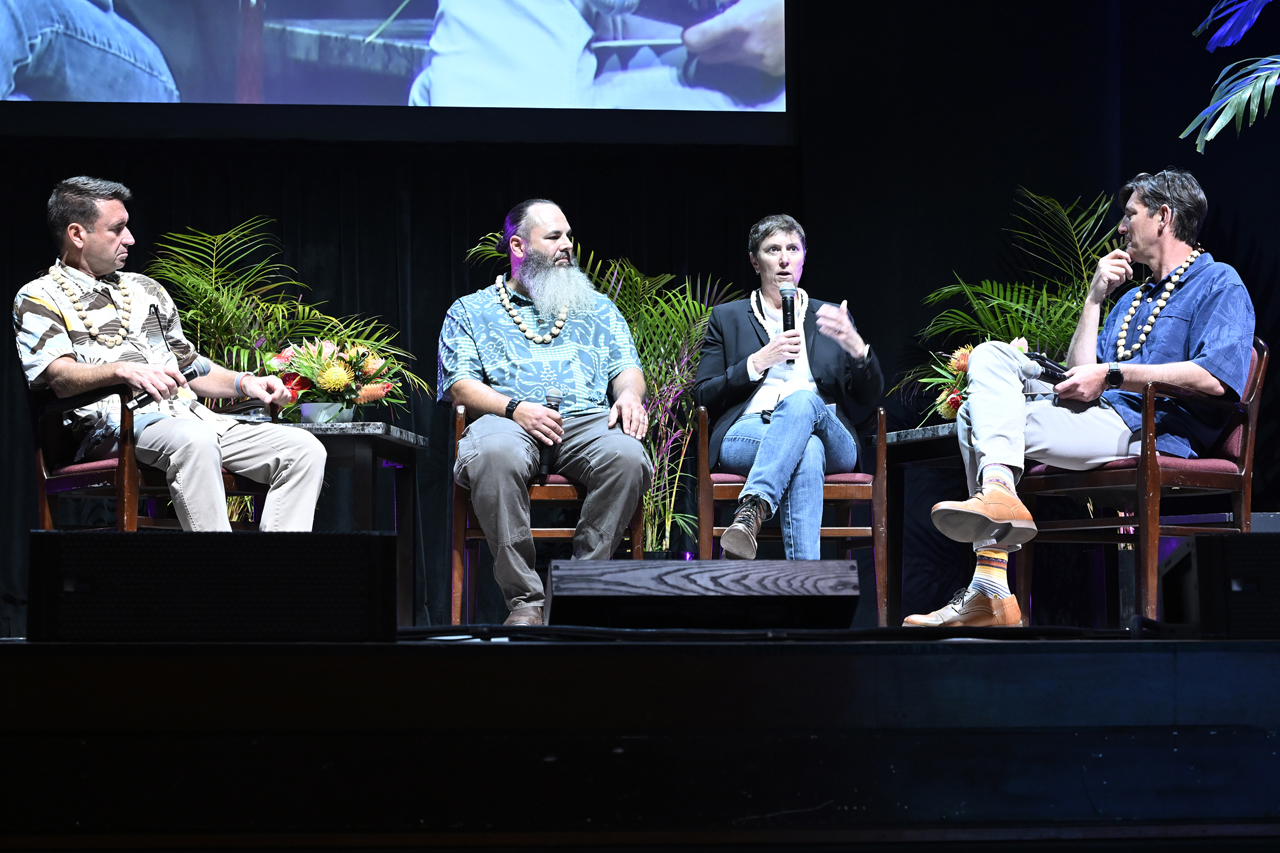
Panel L to R Brad Rockwell, Matthew McNeff, Caroline Thomas Jacobs, Jonathan Koehn address the wildfire threat
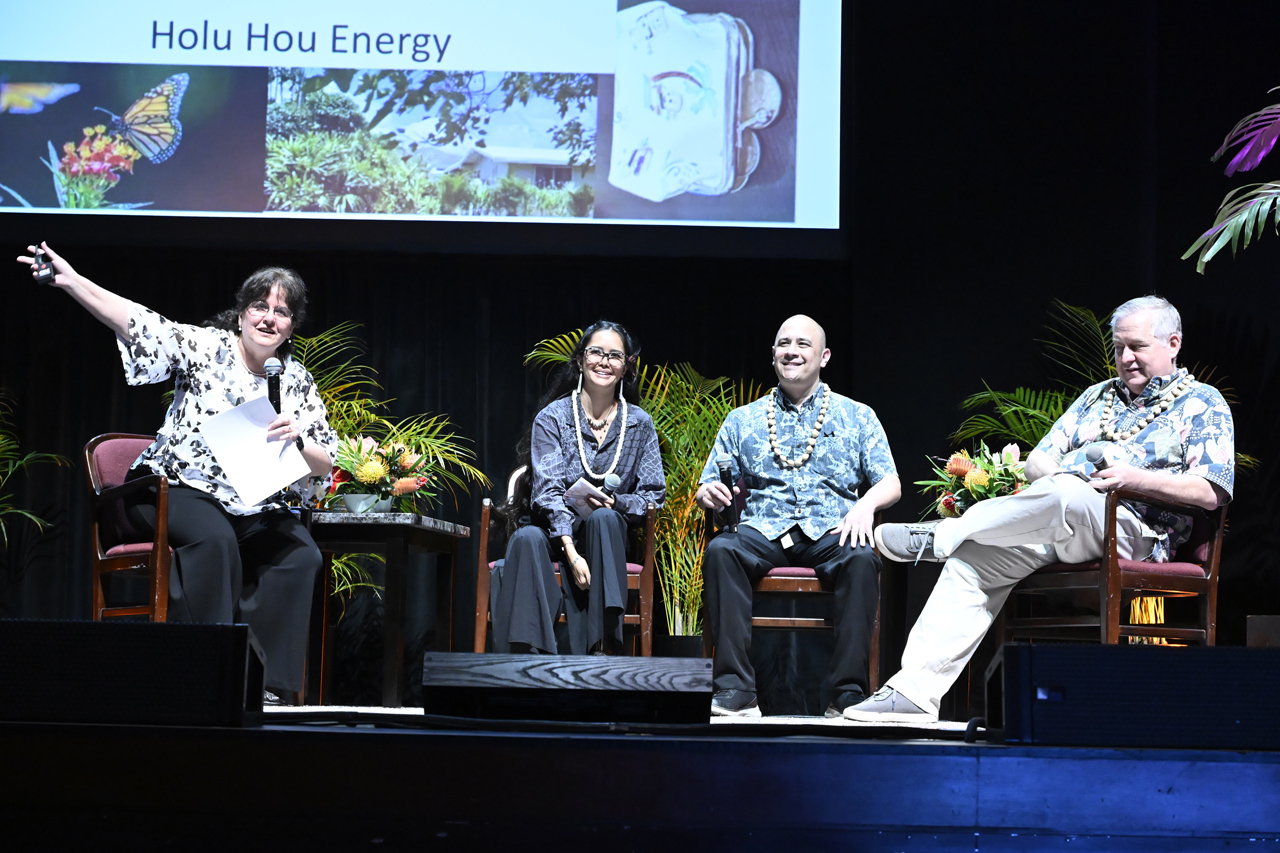
Panel L to R: Maria Tome, Leilani Chow, Joe Kent and Ted Peck discuss Community Energy Priorities
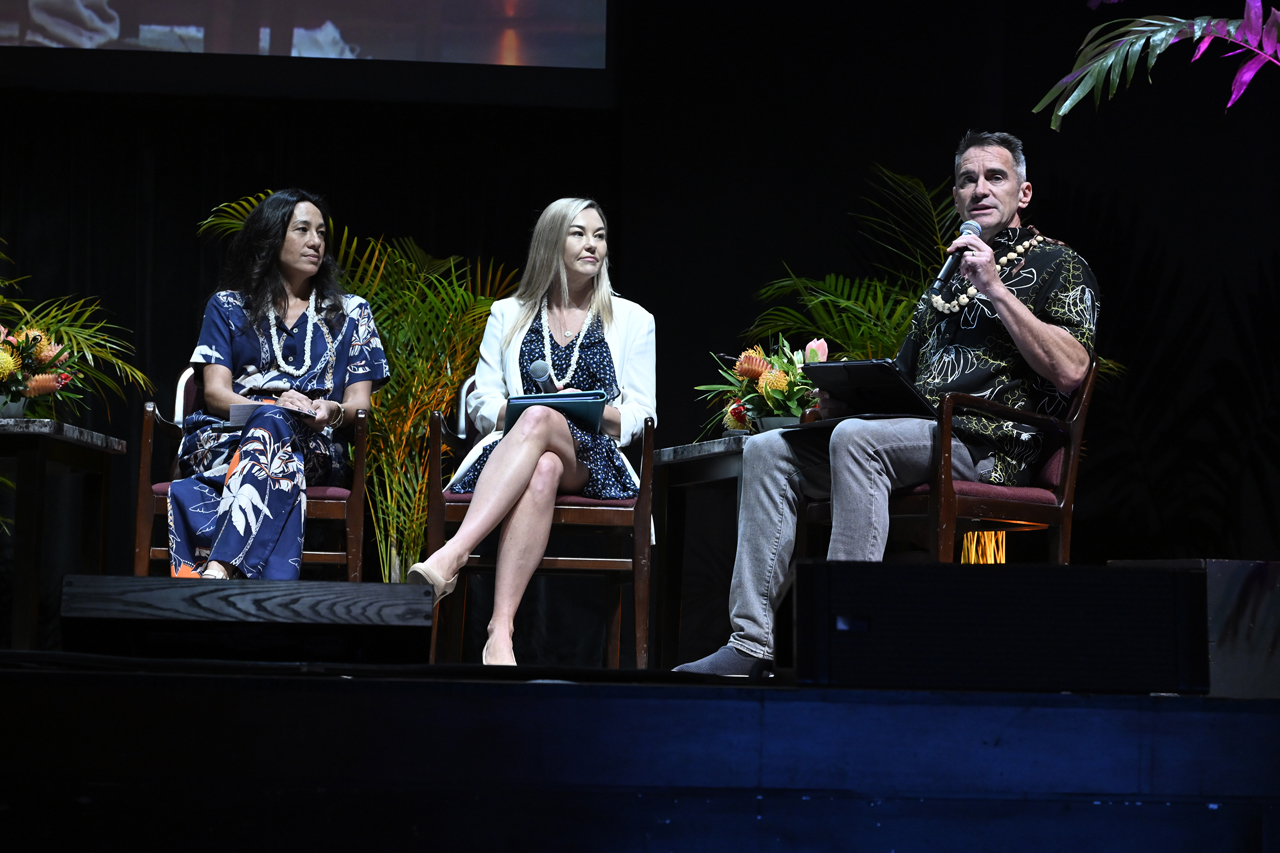
Kirstin Punu and Nicola Park join Wren Wescoatt to discuss Utility Scale Solar
Community Energy Priorities
After lunch, the conference turned to community energy priorities with a panel led by Maria Tome of the Consumer Advocacy office. The discussion featured perspectives from Leilani Chow of the Molokai Clean Energy Hui, Joe Kent of the Grassroot Institute, and Ted Peck of Holu Hou Energy. Each emphasized the need for energy solutions that are co-designed with and for local communities—not imposed from above.
“We went from a community who has historically opposed every single large-scale renewable energy project ever, to designing ten of our own,” Leilani Chow explained. “We built our own planning process—community-initiated, community-driven, and community-led.”
Kent outlined potential reforms, including a streamlined permitting process, self-certification for rooftop solar, and reforming the Jones Act to lower shipping costs for LNG. “We need to stop requiring 10 layers of approval when one or two would do,” he urged. “States that build quickly allow people to build.”
Ted Peck highlighted the untapped potential of rooftop solar on multi-dwelling units (MDUs), which have largely been excluded from Hawaii’s solar transformation. “A quarter to a third of our grid’s energy could come from rooftops, especially MDUs, if we address financing, permitting, and structural barriers,” he said. “With smart inverters and storage, rooftop systems can be great grid citizens.”
Utility Scale Solar
The next session dove into the state of utility-scale solar development, with Wren Wescoatt of Longroad Energy moderating a practical and forward-looking discussion with Nicola Park of Clearway Energy and Kirstin Punu from AES Hawaii. They examined how developers are navigating tariffs, supply chain disruptions, and credit risks to keep big projects on track.
Wescoatt opened the session by describing the complex process of utility-scale project development, noting, “We find land for projects…negotiate with landowners, discuss the project with community stakeholders…and then build, test, and commission the project.” He emphasized that while the process ideally takes three to four years, “something unexpected always happens,” coining the acronym “SHET” for “Surprising, Horrible, External, Terminable” events that derail projects.
Nicola Park elaborated on the challenges developers face, citing COVID-19, supply chain disruptions, and tariff uncertainties, highlighting the financial strain caused by these disruptions, noting that some projects saw price increases of up to 56%. Kirsten Punu added that Hawaii’s unique land constraints and cultural considerations further complicate development.
The panelists proposed several solutions to improve project viability. Nicola advocated for pricing flexibility in power purchase agreements (PPAs), referencing a Colorado precedent: “The PUC of Colorado recently approved a pricing amendment for tariff and ITC risk… with independent auditor involvement.”
Kirsten emphasized the importance of local control and reform: “We need to understand that there is some equitability in the contracting.” Both stressed the need for better alignment between land use policy and renewable energy goals.
Featured Conversation
This conversation was facilitated by Doug McLeod of DKK Energy Services and a member of the Conference committee to explore the complexities of community engagement in Hawaii’s energy transition. Stacey Alapai shared her journey from a concerned resident facing high energy bills to co-founding the Upcountry Energy Resilience Project. Her grassroots approach aims to shift the traditional top-down model of energy development by empowering local voices to lead and developers to respond. She highlighted the importance of curiosity, public learning, and building trust through transparency and accessibility.
Henry Curtis, representing Life of the Land, brought decades of advocacy experience, emphasizing the systemic exclusion of community voices from energy decision-making. Curtis stressed that communities must have the power to say “no” and that meaningful engagement requires simplifying complex issues. Both panelists underscored the need for creative, inclusive thinking and cross-sector collaboration, especially as Hawaii pursues its 100% renewable energy goals. They concluded with a call to reframe energy policy around tangible community outcomes, such as affordable electricity, rather than abstract legislative targets
Unlocking the Value of Grid Services and Virtual Power Plants (VPPs)
The final panel discussion of the day focused on the growing role of Virtual Power Plants (VPPs) and grid services in supporting energy transitions. Moderator Jay Griffin explained VPPs as a way to aggregate flexible energy resources—like solar panels, batteries, and EV chargers—to support the grid during peak demand. He cited Department of Energy reports showing that VPPs could provide 10–20% of peak demand cost-effectively, especially crucial as aging infrastructure is replaced with renewables.
Commissioner Antonio Torres Miranda shared Puerto Rico’s success with its Customer Battery Energy Sharing (CBES) program, which grew from under 100 people in 2023 to 9,500 participants 18 months later and 21 MW of dispatchable power, making it the second-largest VPP in the U.S. He emphasized customer empowerment and flexibility: “The clients have total control…they can opt out in any event being called.” The program is now expanding into CBES+ with auto-enrollment and a goal of 60 MW and 48,000 customers.
Panelists Brian Gold and Walker Wright highlighted the importance of simplicity, fair compensation, and consumer trust in driving adoption. Gold noted Hawaii’s energy-aware population and stressed that programs must be easy to understand and implement. Wright emphasized the shift from solar-only to solar-plus-storage systems and the need to leverage private investment for public grid benefits. The panel concluded with reflections on international models, particularly the UK’s advanced interconnection and demand flexibility systems, and a call to continue innovating to meet clean energy goals.
HIGHLIGHTS FROM DAY 2
Outcomes of the Deep Dive Session
The Day 2 opening session focused on the outcomes of a deep dive into Time-of-Use (TOU) electricity rates in Hawaii, featuring Jenny Potter from the Hawaii Natural Energy Institute and Dr. Ahmad Faruqui, an economist-at large.
Potter outlined Hawaii’s journey with TOU rates, including a pilot program with Hawaiian Electric involving 14,000 customers. While the pilot showed modest reductions in peak consumption, it lacked significant load shifting. She emphasized the importance of tailoring TOU rates to different customer profiles (e.g., EV owners, solar users, low-income households) and highlighted how Hawaii’s energy landscape—now saturated with battery storage— “We are actually energy constrained now and not capacity constrained,” especially on low solar days.
Dr. Faruqui offered a broader, global perspective, strongly advocating for TOU rates as a tool for fairness and efficiency. He criticized flat rates as inherently unjust: “Flat rates are the most inequitable rate design in history… they are creating a transfer of wealth from those customers who are less peaky intensive to those who are more peaky intensive.” He urged Hawaii not to abandon TOU innovation and highlighted the importance of smart meters and automation, and pointed to successful examples in California and Arizona.
He concluded with a call to action: “Leave the door open, don’t close the door… let customers who find those rates attractive sign on to those rates. They will lower their bills.” The session ended with a shared sentiment that while TOU rates are not a cure-all, they are a valuable part of a broader strategy that includes affordability programs, equity considerations, and technological integration.
Why Not Nuclear?
Moderator Michael Colón of Ulupono Initiative explained the title of this next panel as a question to Governor Green’s call to consider all energy options—except nuclear. Panelists explored the potential role of nuclear energy in Hawaii’s clean energy future. Marcus Nicol from the Nuclear Energy Institute, Madison Schroeder from Generation Atomic, and Jack Shriver of Power Engineers discussed the evolution of nuclear technology, emphasizing the safety, efficiency, and compactness of modern reactors—particularly small modular and microreactors, which could suit Hawaii’s grid and land constraints. Nicol noted, “We only use 5% of the energy in nuclear fuel,” highlighting the potential for future recycling. The panel also addressed Hawaii’s legal barriers, including a constitutional prohibition, and emphasized that while nuclear is not currently classified as renewable, that definition could be reconsidered.
Safety and waste management were key concerns. The panelists stressed nuclear’s strong safety record—“zero people died from radiation at Three Mile Island or Fukushima,” Shriver noted—and explained that used fuel is solid, compact, and safely stored. They also emphasized the importance of community engagement, with Schroeder stating, “Trust in institutions…is harder to address” than technical facts. The discussion concluded with a call for informed, inclusive dialogue, recognizing that nuclear energy, while not without challenges, could offer a reliable, low-carbon complement to Hawaii’s renewable energy mix.

Dr. Ahmad Faruqui and Jennifer Potter report on the outcomes of the Deep Dive Session
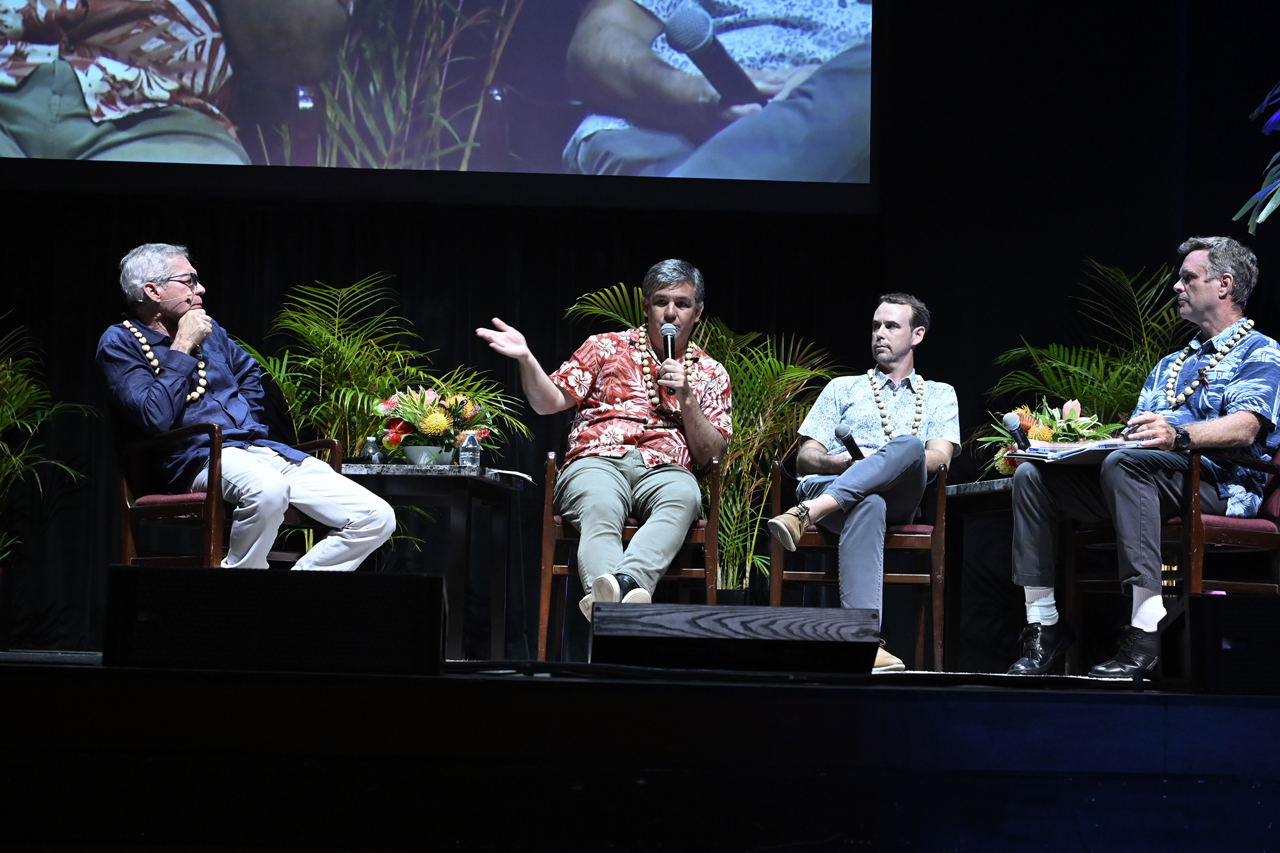
Panel L to R: Antonio Torres-Miranda, Walker Wright, Brian Gold and Jay Griffin discuss grids and VPPs.
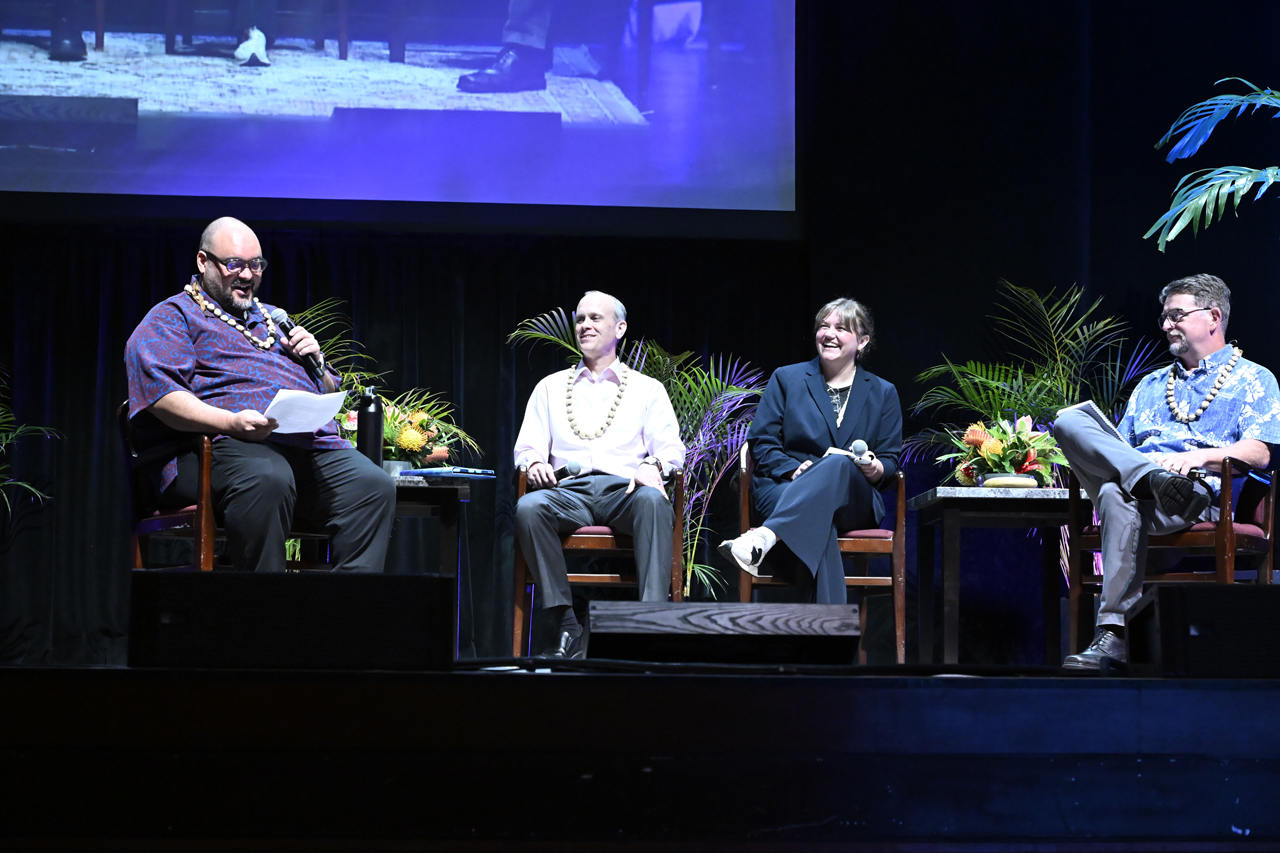
Panel L to R: Michael Colon, Marcus Nichol, Madison Schroder and Jack Shriver discuss Why Not Nuclear?
Unlocking Capital for Infrastructure with Usage-Based Funding
Lila Berg and the Hawaii team from Sustainability Partners (SP), introduced an innovative model for financing essential infrastructure without upfront capital or long-term debt. The panel emphasized a commitment to long-term environmental, social, and financial outcomes, highlighting their collaborative, vendor-agnostic model that includes design, maintenance, and adaptability to evolving technologies.
Watts Up with Maui Generation?
In this featured presentation, Hawaiian Electric’s Vice President of Power Supply, Michael DiCaprio, discussed the current and future state of power generation on Maui. DiCaprio detailed the planned retirement of the aging Kahului Power Plant by 2028 due to air permit constraints, and its partial conversion into synchronous condensers to support voltage stability and grid reliability. He also addressed challenges at the Maalaea Power Plant, including parts shortages for key generators, and outlined strategic maintenance and upgrades to extend their operation. Looking ahead, DiCaprio highlighted the upcoming Waena Battery project and a 40 MW firm generation facility, both sited on Hawaiian Electric property, as critical components of Maui’s clean energy transition.
Energy Efficiency
After lunch, Caroline Carl of Hawaii Energy introduced her panel to explore how energy efficiency can be a powerful tool in addressing Hawaii’s affordability and housing crises. Carl highlighted the paradox of Hawaii’s low residential energy use but high electricity costs, noting that “one in four Hawaii residents found themselves unable to pay part or all of their energy bill” in the past year. She emphasized that while energy efficiency alone won’t solve the state’s energy challenges, it remains a critical and underutilized solution that must evolve to meet changing needs.
anelists Brian Kealoha (VEIC), Melanie Islam (Mason Architects), and Alana Kobayashi-Pakala (Kobayashi Group) emphasized that while Hawaii has low residential energy use, high electricity costs and rising shut-off rates show that more must be done.
Kealoha noted that “for every dollar spent [on energy efficiency], participants see $25 in benefits,” advocating for more flexible, outcome-driven program design. Kealoha also emphasized the need for early intervention in building design, noting that “you can’t retrofit centralized solar water heating after the building’s built.”
Islam and Kobayashi-Pakala shared how early design decisions, passive cooling, and centralized solar hot water systems can significantly reduce long-term energy costs, especially in affordable housing. Tailoring energy efficiency solutions to Hawaii’s unique climate, Islam reflected, “How do we capture the trade winds, how do we bring in daylight to reduce our electrical lighting loads—all of these things that make common sense so that when we do have opportunity to bring in more efficient units, it’s just a smaller energy footprint to work with.”
Kobayashi-Pakala highlighted the success of centralized solar hot water systems in reducing resident energy bills, noting that in one project, the $1,200 per-unit investment was paid back within a year. However, she cautioned against mandates without incentives—“We need rules,” she said, “but we also need carrots. Height and density are the best carrots that pay back.”
The panel concluded with a call for performance-based codes, non-monetary incentives, and better alignment between land use regulations and energy goals.
Offering Solutions: Roundtable Discussion
Members of the program committee came together to give an overview of the solutions discussed so far in the program and answer questions that had come up from the audience. Jonathan Koehn returned to the stage and was joined by Colton Ching, Senior Vice President, Planning & Technology, Hawaiian Electric; Jacqui Hoover, Jacqui Hoover, Conference Chair and Executive Director and COO Hawaii Island Economic Development Board (HIEDB) and President Hawaii Leeward Planning; and Doug McLeod, DKK Energy Services, LLC.
There was a strong emphasis on collaboration, innovation, and community engagement. Ching opened by highlighting the need for a more structured and proactive approach to siting renewable energy projects, drawing inspiration from practices in California and Texas. He advocated pre-designated development zones and utility-led infrastructure planning to streamline project implementation. Koehn urged the audience to remember the human and environmental motivations behind energy goals. He emphasized that success should not be measured solely by numerical targets but by the broader impact on resilience, equity, and community empowerment.
McLeod pointed to the rapid advancements in China’s EV infrastructure—such as five-minute charging—and the implications for Hawaii’s grid planning. He also raised concerns about the Hawaii Public Utilities Commission (PUC) being overburdened and suggested exploring the creation of a separate energy commission. Hoover concluded the session by calling for a shift from divisive narratives to a more unified, relationship-based approach. She stressed the importance of leveraging limited resources collaboratively and fostering ongoing, honest dialogue across all stakeholders. The panel collectively underscored that Hawaii’s unique context demands innovative, inclusive, and forward-thinking energy strategies.
Powering the Future—Battery Storage, Safety & Building a Strong Workforce
The battery storage panel, moderated by Damien Kim, Business Manager and Financial Secretary of International Brotherhood Electrical Workers (IBEW) Local 1186, spotlighted the rapid growth of energy storage, its critical role in Hawaii’s clean energy transition, and the urgent need for advanced safety training. Bernie Kotlier, Executive Director, Labor Management Cooperation Committee, California emphasized that battery storage is now essential for replacing fossil fuel baseload power, citing Hawaii’s Kapolei project as a model. He warned, however, of serious safety risks like thermal runaway and arc flash, which can cause fires, explosions, and toxic emissions. To address this, Kotlier introduced the Energy Storage and Microgrid Training and Certification (ESAMTAC) program, designed to provide licensed electricians with advanced, safety-focused training. “When you put effective training that’s advanced and safety-focused, it will not only increase the growth of sustainable energy, it will keep people safe, and it will reduce risk and liability for everyone,” he said.
Ryan Park of Moss Construction’s Hawaii Division added a developer’s perspective, highlighting the massive labor demand ahead—up to 25 million man-hours over five years—as Hawaii scales up solar and battery projects. Moss, which has built most of Oahu’s utility-scale solar and battery systems, relies on union partnerships and prioritizes safety and retention. Park also addressed policy uncertainty and battery recycling, urging balanced regulation and continued momentum. “A solar spill is a good day,” he quipped, encouraging optimism and collaboration. Both panelists agreed that with the right training, workforce, and policy support, Hawaii can lead the way to a safer, cleaner energy future.
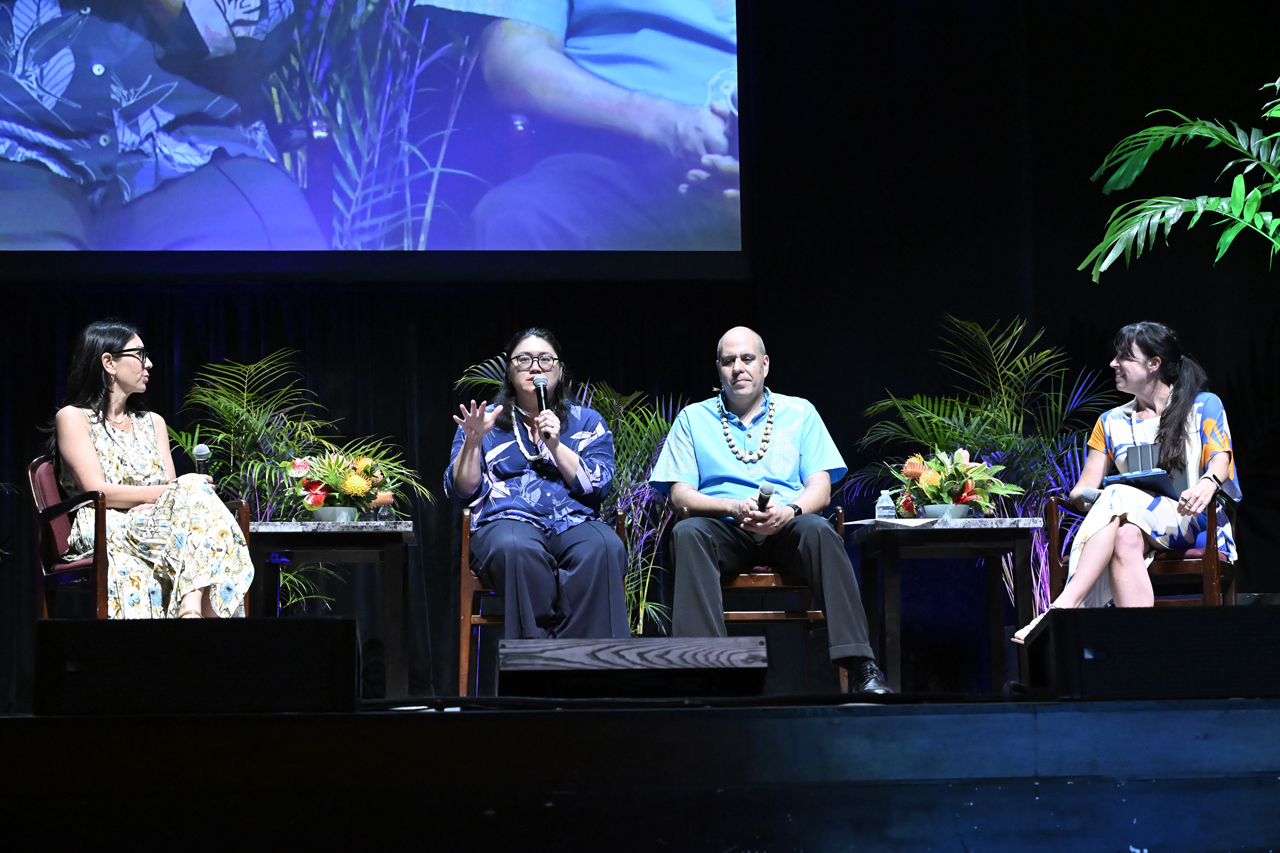
Panel L to R: Alana Kobayashi Pakkala, Melanie Islam, Brian Kealoha and Caroline Carl discuss Energy Efficiency
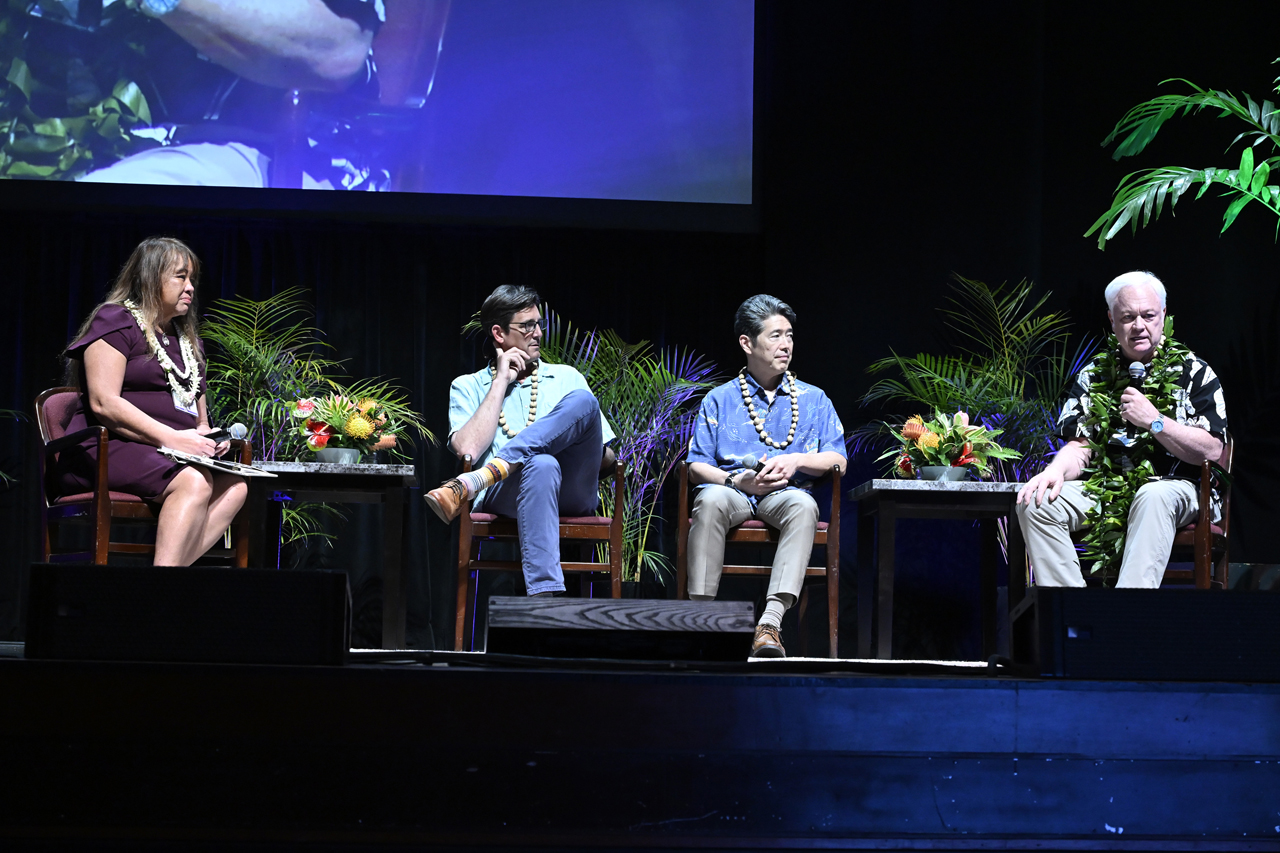
Rountable discussion L to R: Jacqui Hoover, Jonathan Koehn, Colton Ching and Doug McLeod, members of HEC2025 Conference Committee
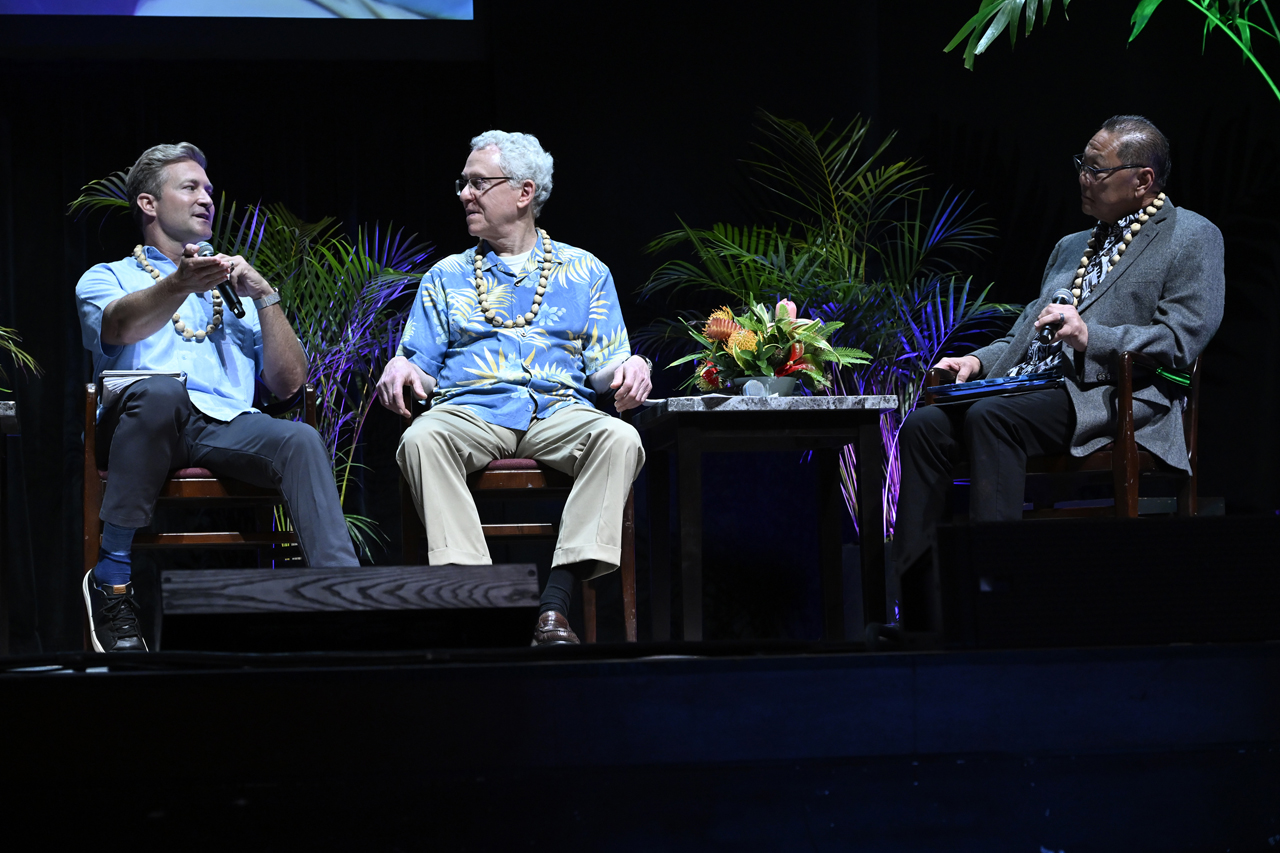
Panel L to R: Ryan Park, ernie Kotlier and Damien Kim discuss powering the future workforce
DER Pathways to Achieve Hawaii’s Renewable Energy Goals
The final panel of the Hawaii Energy Conference brought together key leaders to discuss how distributed energy resources (DERs) like rooftop solar and battery storage can help Hawaii meet its ambitious clean energy targets. Moderator Rocky Mould, Executive Director, Hawaii Solar Energy Association, framed the conversation around three major policy directives: the Hawaii PUC’s 2024 Inclinations, Governor Green’s Executive Order 2501 (which sets a goal of 50,000 new DER systems by 2030), and the state’s 2045 100% renewable energy mandate. PUC Commissioner Colin Yost emphasized the urgency of accelerating DER adoption through new programs like BYOD+ and a forthcoming virtual power plant initiative.
Attorney Kylie Wager Cruz of Earthjustice highlighted the need for simple, well-compensated programs to drive DER adoption, especially for low- and moderate-income (LMI) households. She pointed to the success of the Battery Bonus program and warned that “we don’t have five years to debate what the next program should look like.”
The panel also addressed looming threats to Hawaii’s clean energy progress, including the potential repeal of state and federal solar tax credits. Brad Albert of Nexamp warned, “This is literally the government’s way of putting solar out of business for the benefit of oil.” All panelists agreed that preserving Hawaii’s solar tax credit (HB796) and fighting federal rollbacks is critical. Yost added that the PUC is exploring ways to support programs like GEMS to ensure equitable access to DERs.
Finally, the panel explored how to reform Hawaii’s underperforming community-based renewable energy (CBRE) program. Cruz called for a complete redesign focused on simplicity, adequate compensation, and LMI inclusion. Albert emphasized the need for standard contracts, inflation-adjusted savings, and on-bill credits to make CBRE viable. The panel closed with a call to action: launch a robust VPP program, simplify DER and CBRE offerings, and protect the financial foundations of Hawaii’s clean energy future.
Hawaii Energy Conference a Wrap
Conference chair, Jacqui Hoover, captured the spirit of collaboration and urgency needed to advance the state’s clean energy goals. She urged participants to move beyond divisive narratives—“utilities versus customers,” “ag versus energy”—and instead focus on shared goals and common ground, stating, “Let’s figure out how do we do the ‘and’ rather than ‘versus.’”
Pointing out Hawaii’s unique, relationship-based culture, she emphasized, “We’re on this journey together, on this island together. How do we make this work?” Hoover called for smarter, more unified action: “We need to identify and recognize that we have finite resources. How do we leverage and maximize those resources?”
The 2025 Hawaii Energy Conference underscored the importance of continued dialogue, mutual respect, and collective effort to build a resilient, equitable energy future for Hawaii.
Learn more about the 2025 program and access to session recordings.
The Hawaii Energy Conference is presented by Maui Economic Development Board (MEDB), a 501(c)(3) not-for-profit corporation established in 1982 with a mission to diversify Maui County’s economy, building pathways to innovation, jobs and opportunities for our residents. Through partnerships with the public and private sector, MEDB undertakes projects that assist growth industries with navigating and thriving in our county, educates and trains residents for new careers, and engages our community in forums that determine future economic directions.

